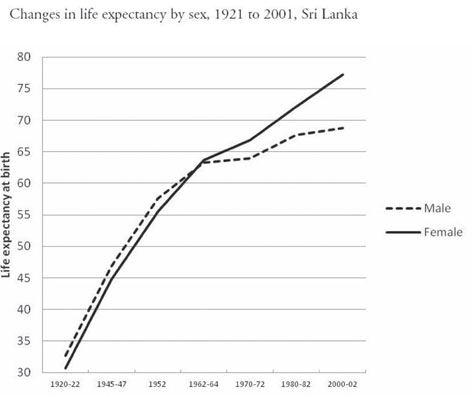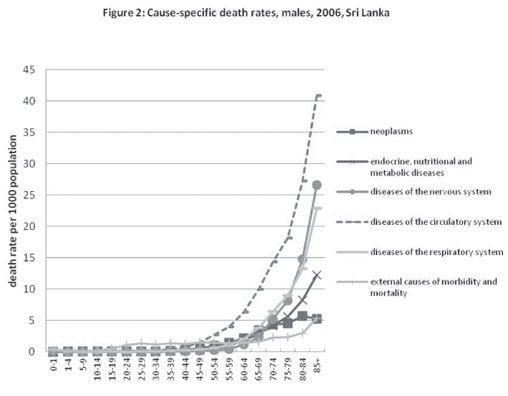
Bad health linked to low life expectancy in men
By Nilma DOLE
The Sri Lankan male mentality is such that they think they’re
invincible to disease and the culture of patriarchy has given rise to
the male perception of being ‘strong’. The problem is by having this
kind of mentality, it means that they hardly go to the doctor and only
seek medical attention once it’s too late. Regular checkups are not part
of the routine with Sri Lankan men as they hardly have any relationship
with their doctor and more often than not, some don’t even go to a
doctor.
 As a result, men have become more prone to conditions such as
diabetes, obesity, heart ailments and cancer which affects them badly in
the late stages. As a result, men have become more prone to conditions such as
diabetes, obesity, heart ailments and cancer which affects them badly in
the late stages.
Prof. Lakshman Dissanayake of the Department of Demography at the
Colombo University told the Sunday Observer that addictions such as
smoking, alcohol consumption in addition to unhealthy eating habits have
contributed to Sri Lankan men living much less than women. “The sad
plight is the loss of husbands contributing to a long widowhood in women
and children losing their fathers at an early age. So we should aim to
increase the longevity of men so that elderly couples can age gracefully
together,” said the professor.
Life expectancy at birth for men was 32.7 and women was 30.7 in the
1920s but in 2002, female life expectancy at 77.2 years surpassed the
male life expectancy which was 68.8 years.
The projected figures show that male life expectancy is expected to
reach 72.3 years while female life expectancy will be 82.5 years by 2026
(Gunasekera, 2008).
Annual gain
According to the professor, the total as well as average annual gain
in life years was more than double for females. Therefore, men seem to
be increasingly exposed to high risk mortality factors.
“In relation to the diseases of the circulatory system, nervous
system, respiratory system, endocrine, nutritional and metabolic
diseases and external causes of morbidity and mortality, men are in a
more hostile position in promoting their survival chances,” said the
doctor.
Although most of these causes are amenable to medical intervention,
sex differentials of mortality can be attributed to factors other than
such interventions.
 The research paper titled, ‘Avoidable mortality and men’s health
status in Sri Lanka’ done by Prof. Dissanayake has stated that the focus
on men’s health in Sri Lanka is rarely visible and can be regarded as a
largely neglected health aspect. “Although there are general discussions
about the gender gap in life expectancies, a serious attempt has not
been taken so far to provide a rational explanation for such a
significant difference. The research paper titled, ‘Avoidable mortality and men’s health
status in Sri Lanka’ done by Prof. Dissanayake has stated that the focus
on men’s health in Sri Lanka is rarely visible and can be regarded as a
largely neglected health aspect. “Although there are general discussions
about the gender gap in life expectancies, a serious attempt has not
been taken so far to provide a rational explanation for such a
significant difference.
Therefore, an awareness of the actual disparity that exists with
men’s health still remains ignored,” he said.Age and sex-specific death
rate due to diseases of the circulatory system show that there is a
considerable difference of its prevalence between men and women,
especially after 40 years of age.
After the age of 40, the death rate of men than women is higher at
each age and the gap becomes wider, especially between 60 and 75. Among
the diseases of the circulatory system, ischemic heart diseases, other
heart diseases, hypertensive diseases and cerebrovascular diseases are
the greatest killers of men during those ages in Sri Lanka.
Deaths
According to the professor, the proportion of male deaths to total
deaths of all these four causes during the ages 50 to 74 demonstrates
that these causes constitute 56 percent of total deaths due to the
diseases of the circulatory system.
He said, “It is quite interesting to observe that the widening gap
between the sexes emerges only after the menopause is reached and hence
women no longer have the same immunity like what they experience during
the childbearing years against these diseases.
In such a situation, we need to expect that the morbidity status of
both men and women to be not different if other factors affecting are
equal.”
Therefore, the only theory that can rationally explain these
statistics is that metabolic syndrome, mental depression and smoking are
related to behaviourial patterns which are determined by factors outside
the medical care system.
“This causes the difference of the prevalence of diseases of the
circulatory system between men and women,” said the professor.
About 71 percent of the change in temporary life expectancy between
men and women can be attributed to the difference in deaths due to these
diseases. Different occupational conditions and specific lifestyle
patterns have played key roles in making a significant difference
between life expectancies of men and women.
“Health awareness given to women through exceptionally successful
maternal and child health program available throughout Sri Lanka have
played a key role in making women more health conscious than their male
counterparts,” said Prof. Dissanayake.
Public health midwives or family health workers in the country play a
significant role in addressing reproductive health related issues which
also suggests that women are in a more beneficial position to be health
conscious during and also even after child-bearing span.
Deaths due to malignant neoplasm of lip, oral cavity and pharynx
recorded highest number of deaths among neoplasms category and it
accounted for 9.3 percent of all deaths in that group.
Addictions
 It is a commonly known fact that tobacco and alcohol consumption are
the two leading risk factors for those diseases and thus linked to
specific lifestyle patterns. It is a commonly known fact that tobacco and alcohol consumption are
the two leading risk factors for those diseases and thus linked to
specific lifestyle patterns.
According to Prof. Dissanayake’s study, the selected causes for this
study are significant as Sri Lanka could have added 2.8 years to men’s
life expectancy between birth and 75 years of age if those diseases were
prevented at least to the levels of women’s mortality.
“In Sri Lanka, these risks are related more to men than women since
prevalence of smoking and drinking is higher among men,” said the
professor.
“Sri Lanka’s maternal and child health program could have had a
significant impact on the reduction of women’s overall mortality level
because of their more awareness of health issues,” said Prof.
Dissanayake.
Lack of special programs for men’s health unlike the former together
with cultural beliefs about masculinity may also have had considerable
effect on deterioration of men’s health.
He said that an additional effort has to be taken to improve the
health status of men to be par with women in order to advance their
health standing and thus diminution of their vulnerability position to
the above causes of death.
So, healthy lifestyles for men should be promoted in addition to
eating right food plus regular checkups and healthy relationships with
doctors should be promoted to make the Sri Lankan man live longer.
According to the professor, preventive programs are needed to
decrease both morbidity and mortality due to such causes.
“One way of tackling this major public health issue would be
introduction of successful interventions from the developed world,” said
the professor.
Analysis
As outlined in the methodological section of his paper, a life table
analysis was performed in order to find the contribution made from each
cause of death category to the gap between life expectancies of men and
women. Such an analysis provides a unique opportunity to understand the
relative significance of each cause of death category in the reduction
of survival chances of men.
The total difference between temporary life expectancies of men and
women were four years in 2006. Prof. Dissanayake said, “When major
causes of death categories selected for this study are adjusted for both
men and women, the difference becomes 2.8248 years.”
He said that this shows that if both sexes are not exposed to the six
categories of causes of death, the difference is reduced by 1.1752
years.
“This research will allow us to examine how much contribution that
each cause of death category made for men to have 2.8248 life years less
than women.
Alcoholism leads to higher rates of general and cancer-related
deaths
Alcohol consumption causes approximately four percent of all deaths
worldwide and is responsible for roughly five percent of global
diseases. A study of alcohol consumption in Tuscany, Italy has found
that alcoholics have significantly higher rates of both general and
cancer mortality when compared to the general population.
Results will be published in the February 2012 issue of Alcoholism:
Clinical & Experimental Research and are currently available at Early
View.
“[We conducted this study of] mortality rates [among] this relatively
large group of alcoholics because of our interest in better
understanding the risk profile of alcoholism,” explained Domenico Palli,
head of the Nutritional and Molecular Epidemiology Unit at the Cancer
Research and Prevention Institute (ISPO) in Florence, and corresponding
author for the study. “The higher number of male alcoholics in our group
reflects the distribution of alcohol consumption in the Italian
population.”
“There have been other studies of the relationship between alcohol
and mortality but not with so many addicted people and particularly
those with cancer,” added Emanuele Scafato, director of the World Health
Organisation Collaborating Centre for Research & Health Promotion on
Alcohol and Alcohol-Related Problems at the Istituto Superiore di
Sanitŕ.
“From an epidemiological point of view, this is a unique opportunity
to examine health experiences and outcomes due to long-term hazardous
and harmful consumption of a toxic and well-known carcinogenic that has
resulted in alcohol dependence. This is relevant from a public-health
perspective in order to formulate caution messages to the public to
increase levels of awareness about the need for a healthier lifestyle
and really moderate alcohol consumption.”
Palli and his colleagues gathered data on 2,272 alcoholics (1,467
males, 805 females), predominantly middle-aged, who were treated at the
Alcohol Center of Florence during the period of April 1985 through
September 2001, for a total of 21,855 person-years. Expected deaths were
estimated by using age, gender, and calendar-specific regional mortality
rates.
“Our study has provided strong evidence that alcohol addiction
significantly increases the risk of death from several causes in
comparison to the general population in a Mediterranean country,” said
Palli. “The alcoholics seemed to be at greater risk of mortality for
specific diseases such as infections, diabetes, diseases of the
immunological, nervous, cardiovascular, respiratory, and digestive
systems, as well as violent causes.
Alcohol’s role as a ‘dietary’ carcinogen emerged quite clearly. The
highest risks were found for cancers of the pharynx, oral cavity, liver,
and larynx, but also the risk of other cancers - esophagus, rectum,
pancreas, female breast “ was increased.”
“This research is certainly a step in the right direction in order to
foster awareness not only for addicted people but for the general
population as well,” said Scafato. “It is also important for health
professionals to increase levels of valid information and competent
actions aimed at prevention, early identification, advice, and helping
people change.
It is furthermore one more tool for better dealing with a counter
productive and misleading information spread mainly by commercial
interests that always give a positive image of drinkers, portraying
drinking as a ‘must’ behaviour. Those who are advised or believe that
one glass could be good for the heart, they should also be aware that
WHO councils that for many people, females and the elderly for example,
just a bit more than a glass increases the risk of 60 diseases and 14
cancers.
This is what prevention needs to address in terms of informed
choices, keeping in mind that hazardous alcohol use always produces more
harm than benefits at the population level.”
The results also showed that female alcoholics reported higher
survival rates than male alcoholics. “Perhaps female alcoholics are more
likely to obtain help and achieve remission, tend to benefit more than
men from continued participation in treatment programs, and/or tend to
be referred to specific alcohol centre earlier than men, who often are
admitted with advanced disease or only when severe symptoms emerge,”
said Palli.
“Women usually live longer than males on average,” added Scafato,
“and are much more keen to control their health status; they also tend
to have a higher probability of receiving medical interventions due to a
different social networking and mutual gender support.”
Clearly alcohol abuse can compromise the structure and functionality
of several human organs, thus directly increasing the risk of death,”
said Palli.
“Other aspects of the characteristic life-style of alcoholics -
smoking, drug abuse, promiscuity and a poor diet - may contribute to
this high-risk pattern together with reduced health-consciousness.”
Medicalxpress.com
Researcher examines how the brain perceives shades of grey
How the brain perceives colour is one of its more impressive tricks.
It is able to keep a stable perception of an object’s colour as lighting
conditions change.
 Sarah Allred, an assistant professor of psychology conducted the
research with Alan L. Gilchrist, a professor of psychology at
Rutgers-Newark, and professor David H. Brainard and post-doctoral fellow
Ana Radonjic, both of the University of Pennsylvania. Sarah Allred, an assistant professor of psychology conducted the
research with Alan L. Gilchrist, a professor of psychology at
Rutgers-Newark, and professor David H. Brainard and post-doctoral fellow
Ana Radonjic, both of the University of Pennsylvania.
“Although we recognise easily the colours of objects in many
different environments, this is a difficult problem for the brain,”
Allred says. “For example, consider just the grey scale that goes from
black to white. A white piece of paper in bright sunlight reflects
thousands of times more light to the eye than a white piece of paper
indoors, but both pieces of paper look white. How does the brain do
this?”
The process of seeing an object begins when light reflected off that
object hits the light-sensitive structures in the eye. The perception of
an object’s lightness (in terms of color shade) depends on the object’s
reflectance. Objects that appear lighter reflect a larger percentage of
light than those that appear darker.
Differences
Allred says the brain processes perceptual differences between black
and white objects even when illumination of the object changes.
If the brain did not do this, it would fail to distinguish colour
shade in different light.
In general, white objects reflect about 90 percent of the light that
hits them, and black objects reflect about three percent, a ratio of
30-to-1, she explains.
“However, if you look at the intensities of light that enter the eye
from a typical scene, like a field of lilies, that ratio is much higher,
usually somewhere between 10,000-to-1 and a million-to-1,” Allred says.
This happens because in addition to having objects with different
reflectance, real “scenes” also have different levels of illumination.
One example might be a shadowed area under a tree.
- Psypost.com
|

